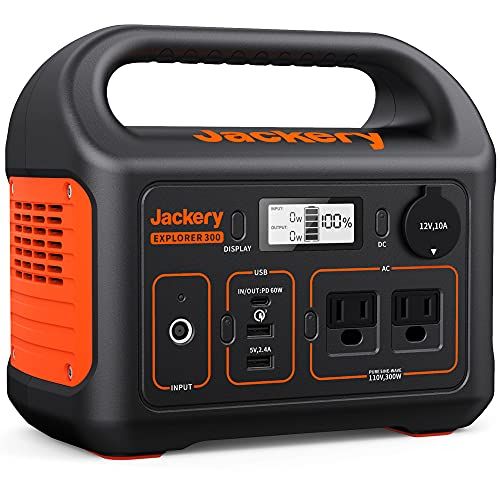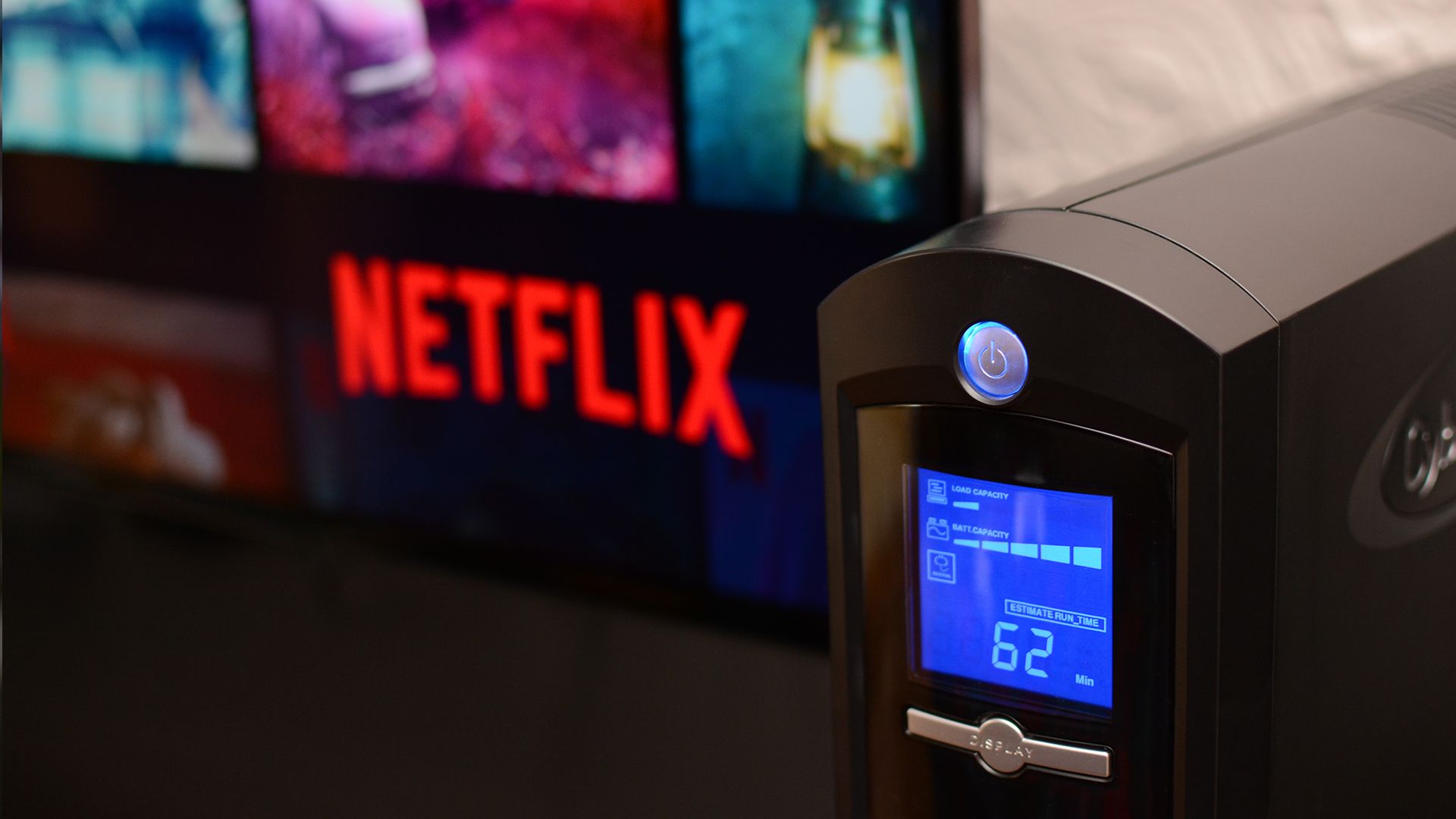Quick Links
Key Takeaways
You can power a TV during a power outage in several ways. The easiest way is battery solutions like UPS units and portable power stations.
People have different priorities during a power outage. If your priority is keeping the TV on so you can binge-watch your favorite show, well, we're here to help. We crunched the numbers on different solutions so you can see just how much (or little) of a hassle a power outage Netflix binge would be.
The TV Thought Exercise and Its Parameters
While writing about all the devices you could hook up to an Uninterruptible Power Supply (UPS) unit, we found ourselves curious about using a UPS to watch TV during a power outage. And, for that matter, all the different ways we could keep a TV on if our only concern during the next power outage was keeping the couch potato good vibes going.
At first glance, it might seem like a silly exercise if you're not that bent on keeping your TV glowing during a power outage, but it's also a fun way to compare different methods of powering not just your TV but other devices during a power outage.
To keep our analysis relatively consistent across devices, we're operating off two assumptions. Our first assumption is that your TV consumes around 50W of power under load. Our second assumption is that you will need at least 20W of additional power to supply some sort of input to the TV so you can watch something.
This input could be keeping your modem and router on during the outage so you can stream Netflix or it could be to power an attached device like a Bluray player or such. Overall we assume you'll be using about 70W of power.
You can always measure the power consumption of your TV or use our TV power consumption estimation tips to adjust the numbers for your specific setup.
And, of course, you can do things to minimize the amount of power your TV consumes , which is a great first step to making your TV last longer on backup power.
4 Ways to Keep Your TV on During a Power Outage
Large appliances, such as your refrigerator or air conditioners, have high power demands in general as well as a demand "surge" when starting up and cycling components like the compressor. TVs are much simpler devices from a power consumption standpoint.
There is a very minimal spike when first turning the TV on and then a relatively stable power consumption while watching TV that fluctuations up and down based almost entirely on the brightness of a given scene in whatever TV show or movie you're watching.
Because of that low power demand and relative stability, there are a surprisingly large number of ways you can power your TV and basic accessories. We've ranked our solutions by practicality.
In this particular endeavor, practical is something you can do inexpensively with no personal risk or need for a professional (or a very high level of DIY skills), and impractical is something expensive and unlikely to be undertaken unless you're in the market for power solutions that extend beyond just keeping your TV on.
Uninterruptible Power Supply (UPS)
Most people associate UPS units with computers and ensuring data integrity if the power goes out. But really, a UPS is just a very fancy power strip that keeps the power smooth and steady if the lights go out. That smooth transition is one of the biggest UPS selling points. You're not going to find a cheaper way to seamlessly transition from wall power to backup power to ensure your TV show keeps playing even though the lights are flickering.
In our hypothetical situation where you want to keep your TV on (and your Wi-Fi too), a UPS unit could keep your TV up and running for anywhere from 30 minutes to 2 hours, depending on the size of the UPS. Here are some tips to help you size your UPS for your needs.
If you live somewhere with frequent brownouts and blackouts, and often find yourself swearing under your breath because the power goes out just long enough to turn the TV off and mess up your internet connection, a UPS unit is a good solution. For blackouts longer than around an hour, it won't cut it.
Portable Power Station
Advances in battery technology have led to a new product category that simply didn't exist in decades past: the portable power station.
For a few hundred bucks, you can now get a device about the size of a box of copy paper with a substantial lithium-ion battery. Depending on how many Watt-hours (Wh) your particular model is, you can run your TV setup for anywhere from 5-10 hours or so---although once you get to the 10+ hour range you'll be spending more. Models in the 200-300 Wh range cost a few hundred dollars. But when you get up into the 1000+ Wh range, like the Bluetti power station we reviewed, you'll easily spend as much as you would on a small traditional generator.

Jackery Portable Power Station Explorer 300
Small power stations are perfect for powering things like TVs and laptops, or charging your phone during a power outage.
One thing portable power stations have going for them beyond the basic battery backup aspect that UPS units don't is that they're more thoughtfully designed for power outages and have a broader utility beyond just keeping a TV or computer on. And while you're not likely to take a desktop UPS out into the field to go camping or power hobby equipment, a portable power station is quite useful for such tasks.
You can even buy reasonably priced portable solar panels for your portable power station. Armed with one of those, you could charge up your power station during the day to keep your night-time Hulu ritual going.
Car Battery with Inverter
The humble car battery has a surprising amount of energy storage capacity. Although the number of amp hours (Ah) of energy in a battery varies from battery to battery (and the size of the vehicle it was made for), the average is around 75 Ah.
If you pair a car battery with a small DC to AC inverter, you can power your TV setup for around 10 hours. But, because car batteries are not designed for deep cycling (full discharge of the battery), it would be smart to only run the TV setup for a few hours and then run the car to recharge the battery.
Running your car to power your TV, and potentially putting a bit of wear and tear on your expensive car battery if you deeply discharge it, isn't really an optimal solution though. It's worth filing away the car-as-generator trick for a rainy day for those times you really do need emergency power, however. Paired with a suitably sized inverter, one day, your car could keep a freezer full of food from spoiling.
Stand Alone and Whole House Generators
Battery solutions are great if you can store enough power to get through a power outage. And using your car as a makeshift emergency generator is, well, best saved for real emergencies where the wear and tear on your car are worth it.
If you really want to keep your TV on (as well as your lights, fridge, and other things) for an extended period of time, you'll need to consider getting a generator.
On the less expensive side of things, you can get a modest portable generator for your home for around $1000. You fire it up, plug in the things you want to keep running, and go. Although we recommend, you read this guide to hooking up sensitive electronics to generators first. You'll get as much run time as you have fuel, and a five-gallon jug of gasoline will get you days' worth of TV-watching time.
Things get more expensive as you size up the generator for your entire home, install a proper transfer switch, or even consider a whole-house generator. That $1000 outlay for a small portable generator can quickly increase to $10,000 or more when you get into whole-house generator territory. But at that point, it's like you have a UPS for your entire house.
You're not just keeping the TV on for the duration of the power outage, you're keeping everything on. So if your quest for uninterrupted TV binges ends with a home upgrade that keeps your furnace running in the depths of winter so you can Netflix and not be chilled, we'd consider that a win all around.
In the meantime, however, it's probably more economical to pick up a good UPS or a portable power station instead.

